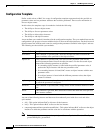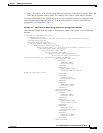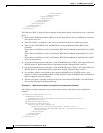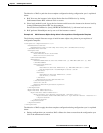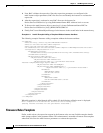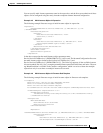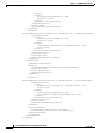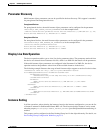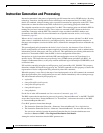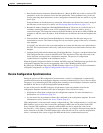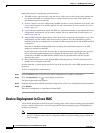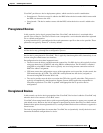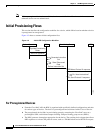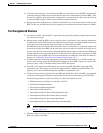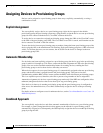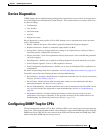
4-14
Cisco Broadband Access Center 3.8 Administrator Guide
OL-27172-01
Chapter 4 CPE Management Overview
Instruction Generation and Processing
Instruction Generation and Processing
Instruction generation is the process of generating specific instruction sets for CWMP devices. By using
technology extensions, through which device technologies are incorporated into Cisco BAC, device
details are combined with provisioning rules to produce instruction sets appropriate to the CPE. These
instructions are then forwarded to the DPEs in the device’s provisioning group and cached there.
The scriptable extensions are also supported in Cisco BAC. The extension points are defined in DPE for
running the java based extension scripts. These scripts are executed in DPE, whenever the device
establishes connection with the DPE. The extension scripts are added in the RDU database and
forwarded to the DPE cache. For more information on scriptable extension service, see Scripting
Framework, page 18-1.
When a device is activated in a Cisco BAC deployment, it initiates contact with the Cisco BAC server.
After contact is established, the device’s preconfigured policy, based on configuration templates or
firmware rules templates associated with the device, determine the management actions undertaken by
the DPE.
This preconfigured policy determines the device’s level of service, also known as Class of Service.
Device configurations can include customer-required provisioning information, such as authentication
information, periodic inform rate, and Class of Service. This authoritative provisioning information for
the device is forwarded to DPEs from the RDU as device configuration instructions.
Instructions are logical operations which the DPE autoconfiguration server (ACS) performs for a
specific device. The instructions may map directly into a CWMP remote procedure call (RPC), for
example, GetParameterValues; or, they may combine additional logic with multiple CWMP RPCs, such
as firmware rules.
IGS could be controlled using the new API property, ApiCommandKeys.IGS_ENABLE. This property
determines whether IGS should be triggered or not. The API command uses this property to control the
regeneration of device configuration being affected by other API commands.
When this property is set to False in the map of associated properties of an API command, the command
skips the regeneration of the configuration process and it returns immediately with a warning message.
The API commands affected by this property are:
• replaceFile
• changeClassOfServiceProperties
• changeProvGroupProperties
• changeNodeProperties
• changeDefaults
For the list of other API commands see Non-concurrent Commands, page 19-2.
The RDU requests that instructions be processed, by passing “InstructionRecords” to the DPE. The DPE
server then converts these “InstructionRecords” to “Instructions”, and returns the results to the RDU
as “InstructionResponseRecords”.
Cisco BAC generates instructions through:
• The Instruction Generation Extension—Generates “InstructionRecords” for a single device.
• The Instruction Generation Service—Generates “InstructionRecords” for more than one device.
You can access statistics from the Instruction Generation Service from the administrator user
interface at Servers > RDU > View Regional Distribution Unit Details.
Among the various instructions that the RDU generates are:



